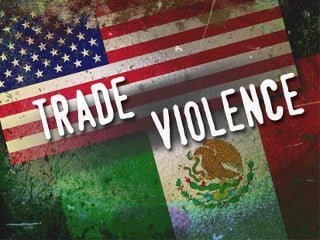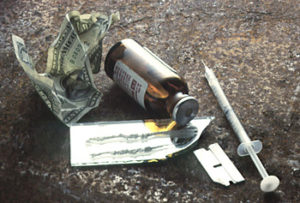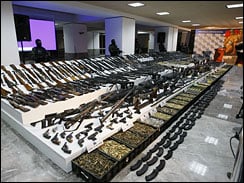
U.S.-Mexico Cross-border Illegal Drug & Weapons Trade Fueling Violence
In a major foreign policy shift, U.S. Secretary of State, Hillary Clinton admitted publicly that an “insatiable demand” by Americans for illegal drugs in the U.S., along with easy – and cheap – access to powerful hand guns and assault rifles are fueling the drug cartel violence at the U.S. – Mexican border. “Our inability to prevent weapons from being illegally smuggled across the border [to Mexico, from the U.S.] to arm these criminals causes the deaths of police officers, soldiers and civilians,” noted Clinton. That violence threatens to spill over across the border into the U.S. Seeking to ease a cross-border relationship strained by the illegal drug trade and cross-border drug trafficking, Secretary Clinton made the clearest acknowledgment yet from the U.S. government of the role American demand for illegal drugs, and the supply of illegal weapons to the drug cartels play in the illicit cross-border narcotics Market.
 In addition to the burgeoning demand & supply of illegal drugs Market, Secretary Clinton noted about the flow of American guns and money into Mexico that criminals are out-gunning Mexican law enforcement. Clinton, referring to guns and military-style equipment like night vision goggles and body armor that the cartels are smuggling into Mexico from the United States, “Clearly, what we have been doing has not worked and it is unfair for our incapacity … to be creating a situation where people are holding the Mexican government and people responsible,” she said. “That’s not right.”
In addition to the burgeoning demand & supply of illegal drugs Market, Secretary Clinton noted about the flow of American guns and money into Mexico that criminals are out-gunning Mexican law enforcement. Clinton, referring to guns and military-style equipment like night vision goggles and body armor that the cartels are smuggling into Mexico from the United States, “Clearly, what we have been doing has not worked and it is unfair for our incapacity … to be creating a situation where people are holding the Mexican government and people responsible,” she said. “That’s not right.”
Mexian President Felipe Calderon has complained for two years that the U.S. isn’t carrying its weight in the cross-border drug war, despite the fact that American drug users and illegal weapons smugglers fuel the problem. “We need to stop the flow of guns and weapons towards Mexico,” President Calderon told U.S. reporters last month. “Let me express to you that we’ve seized in this last two years more than 25,000 weapons and guns, and more than 90 percent of them came from United States, and I’m talking from missiles launchers to machine guns and grenades.”
Secretary Clinton announced the Administration’s plan to boost cooperation to improve security on both sides at a news conference with Mexican Foreign Relations Secretary, Sra. Patricia Espinosa. “The criminals and kingpins spreading violence are trying to corrode the foundations of law, order, friendship and trust between” our two countries. She added, “They will fail,” and that the U.S. ”…will stand shoulder to shoulder with you,” she said after lengthy talks with Espinosa. Earlier, the Obama Administration pledged to send more money, technology and manpower to secure the border in the U.S. Southwest in order help Mexico battle the drug cartels. The White House announced it also sought an additional $80 Mn to help Mexico buy U.S. made military ‘Blackhawk helicopters.’
On Wednesday, U.S. Attorney General Eric Holder promised to enforce a long-ignored ban on importing assault weapons, many of which are re-sold illegally and smuggled into Mexico to re-supply the cartels. Calderon applauded the Obama Administration’s announcements saying it was the first time in many years that the American government was showing a stronger commitment to a mutual problem.
The Illegal Drug Trade

An "insatiable demand" for illicit drugs in the U.S.
Circa the late 1980’s, Mexican drug cartels became the dominant distribution channel for the illegal drug trade in the U.S. These organizations usurped control from Colombian drug cartels after the U.S. – Columbian “War on Drugs” started to curtail the cartels in Columbia. In fact, according to the Drug Enforcement Administration (DEA), Colombian cartels have been limited to predominantly a Caribbean smuggling route into South Florida. Mexican cartels, on-the-other-hand, have access to an expansive 2,000 mile border along several Southwestern states; as well as a vast network of Mexican and Central American – both legal, as well as undocumented – immigrants residing in major metropolitan areas such as L.A., Dallas and Chicago, and later, throughout a number of large and small communities in all corners of the U.S. Based on law enforcement and the accounts of social staticians, most immigrants are hard-working, law-abiding residents and make a contributed to the American economy. However, a few bad apples inevitably turn to the illicit drug trade because of the demand and the perception of “easy profits.”
The number of Mexican and Central American nationals (e.g., El Salvadorans, Guatemalans & Nicaraguans) living in the U.S. occurred as a result of an influx of migrant laborers in search of higher-paying jobs and a better life for themselves and their families. However, the increased presence also brought with it a large number of drug traffickers. Some drug statistics estimate that twenty-three metric tons of cocaine is smuggled into the U.S. annually, two-thirds of which enter across the U.S./Mexican border. The DEA estimates that 80% of the methamphetamine in the U.S. is either manufactured in Mexico or is manufactured in the U.S. by Mexican and Central American drug traffickers operating under the direction of Mexican-based drug cartels. These illicit drug sales in the U.S. have resulted in a boom of revenues for Mexico, and to a lesser extent other Central American nations. In fact, after petroleum revenues, the second largest revenue source for Mexico comes from “foreign remittances” — immigrants sending money back home from the U.S., with a portion of those proceeds coming from illegal drug proceeds.

Display of illegal weapons seized from Mexico-based drug cartels.
In addition to the Mexican drug cartels that engage in torture and killings (at times involving beheadings), armed criminal gangs are notorious kidnappers — prompting some to call Mexico the “kidnapping capital of the world.” This has resulted in a boom for armored car manufacturers and security companies, given that most wealthy people living in the country own armored vehicles, and many employ executive protection teams to provide security for themselves, their families and their homes. Additionally, heavily armed criminal gangs regularly commit armed robberies, muggings and express kidnappings.
The one constant in these violent crimes is guns. Mexico’s robust gun culture stretches back to revolutions, counterrevolutions and revolutionary bandits such as Pancho Villa. Because of this culture, guns are common in Mexico — despite strict gun-control laws and licensing procedures. This demand for guns has created an illicit market that not only is intimately related to the U.S. market for illegal narcotics but also, in many ways, mirrors the dynamics of that market. Drugs flow north and guns flow south — resulting in handsome profits for those willing to run the risks.
Mexican Laws
Similar to the U.S. Constitution, the 1917 Mexican Constitution guarantees Mexico’s inhabitants the right to have “arms of any kind in their possession for their protection and legitimate defense.” However, the constitution includes many caveats on private citizens’ ownership of guns, prohibiting those “expressly forbidden by law” and those “the nation may reserve for the exclusive use of the army, navy or national guard.” Furthermore, Mexican law calls for long prison terms for violators.
Mexico, then, has some of the world’s strictest gun-control laws — making guns difficult to obtain legally. Average citizens who want to purchase guns for self-defense or recreational purposes must first get approval from the government. Then, because there are no private-sector gun stores in the country, they must buy weapons through the Defense Department’s Arms and Ammunition Marketing Division (UCAM). In accordance with Mexican law, the UCAM carefully limits the calibers of guns it sells. For example, it does not sell handguns larger than a .380 or .38 Special. Also, under Mexican law, popular handguns such as .357 magnum revolvers and 9 mm pistols are exclusively reserved for the armed forces.
Regardless of these efforts, the illicit arms market has been thriving for decades — not only because firearm laws are not evenly enforced but also because criminals have found a way to circumvent efforts to stem the flow of guns. Moreover, not all illegal guns are in the hands of cartel members and street criminals. A healthy percentage of them are purchased by affluent Mexicans who are not satisfied with the selection of calibers available through the UCAM. Sources say it is not at all unusual to find Mexicans who own prohibited .357 magnum revolvers or .45 caliber pistols for self-defense against kidnappers and armed robbers. In addition to ballistic considerations, Latin machismo is also a factor — some Mexican men want to own and carry powerful, large-caliber pistols.
The Mechanics of the Gun Trade. . . ß (Read more, click here)